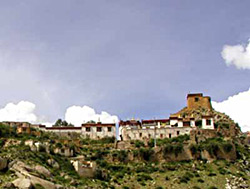As the saying goes, “SeraSe ra is surrounded by hermitages, GandenDga’ ldan is surrounded by self-arisen images, and Drepung’Bras spungs is surrounded by dharma protectors.” Sera Mahāyāna Monastery (Sera Tekchen LingSe ra theg chen gling) is therefore surrounded by hermitages as numerous as the stars on the fifteenth day of the lunar month.
Introduction
Among the three great seats of learning of the GelukDge lugs school, SeraSe ra is the one renowned for its hermitages (ritröri khrod). At least nineteen such institutions are found tucked away in the mountains behind and around SeraSe ra.2 In this section of the Sera Project website, you will learn more about each of these hermitages. To go directly to the Hermitages interactive map, please click here.
The Tibetan compound word ritröri khrod – the word that we translate here as “hermitage” – literally means “in the midst of” or “on the side of” (trö’khrod) “the mountains” (riri).3 Hermitages are small monasteries found in relatively isolated mountain locations. At least in their early stages, they were the homes of individuals variously called “retreatant” (tsampamtshams pa), “meditator” (gomchensgom chen), “recluse” (chikbupagcig bu pa or ensapadben sa pa), and of course “hermit” (ritröpari khrod pa). A hermitage often began as the residence of a single individual,4 but most of them grew. When they became relatively large, they often ceased to be called hermitages and began to be called “monasteries” (gönpadgon pa), but the dividing line between these two terms – hermitage and monastery – is fuzzy. There are some hermitages, for example, that have more monks than many institutions that bear the name “monastery.” Many of Tibet’s greatest monasteries began as the hermitages of individual monks.
Hermitages usually begin as the retreat places of individual monks, tantric priests (ngakpasngags pa), pious male lay practitioners and, less frequently, nuns and laywomen.5 They are the places where these individuals settled for intensive, solitary practice. Originally, these sites may have had no buildings at all but only caves. When a cave did not exist, a monk might have built a simple stone and mud hut for his personal use. A monk often chose as the site of his hermitage a place that was considered holy (né tsa chenpognas rtsa chen po) – places where former saints had lived, places associated with certain deities, or places marked by certain geosacral signs such as self-arisen images or magical springs with curative powers. Holy places are said to bring blessings (jinlapbyin rlabs) to those who reside there. Like a magnifying glass, they have the power to amplify or increase the merit derived from any religious practice performed there, and in general they are said to increase the chances of success in religious practice.
What would a monk have done in his hermitage? He would have engaged in meditation, ritual, study, writing, memorization, and a host of spiritual practices classified together under the general rubric of “ accumulation and purification” (sakjanggsag sbyang).6 Or he might have engaged in a combination of all of these various activities. Even monks who were not committed to eremiticism as a permanent way of life often settled in isolated locations for limited periods of time – for example, when they engaged in short or longer-term deity-focused practices like the so-called “enabling retreat” (lerunglas rung) or “approximation retreat” (nyenpabsnyen pa).7
Many hermits traveled widely before settling on one spot as their permanent residence. And some, of course, never settled at all, but remained itinerant throughout their entire lives. Those monks who chose to settle usually picked a site that provided them with privacy. But the site also had to be relatively close to a populated area – close enough to allow them to obtain food and other necessities (usually in the form of donations from the laity). After remaining at a particular site for some time, the monk might gain a certain level of renown. In this case, he might attract students. If he did, an institution would begin to coalesce around him. First, students would build their own huts close to that of their master, and eventually they might build a temple where the monastic community could come together for rituals and teachings. If the community managed to attract the financial sponsorship of lay patrons, the hermitage would grow. When the original lamabla ma-founder died, the reincarnation might be identified, and in this way the succession would be maintained, and the hermitage would continue to develop as an institution. This is how private retreats evolved into more formal hermitages, and (in some instances at least) into larger monasteries. This is a well-known pattern in the history of Tibetan religious institutions. It is a model applicable not only to the evolution of SeraSe ra’s hermitages but also to other monasteries throughout Tibet.
Hermitages Home
Table of Contents
- Introduction
- Location and Institutional Affiliation to SeraSe ra
- History
- Life in the SeraSe ra Hermitages
- Glossary
- Notes
- Specify View:
- Specify Format:
 |  |  |
